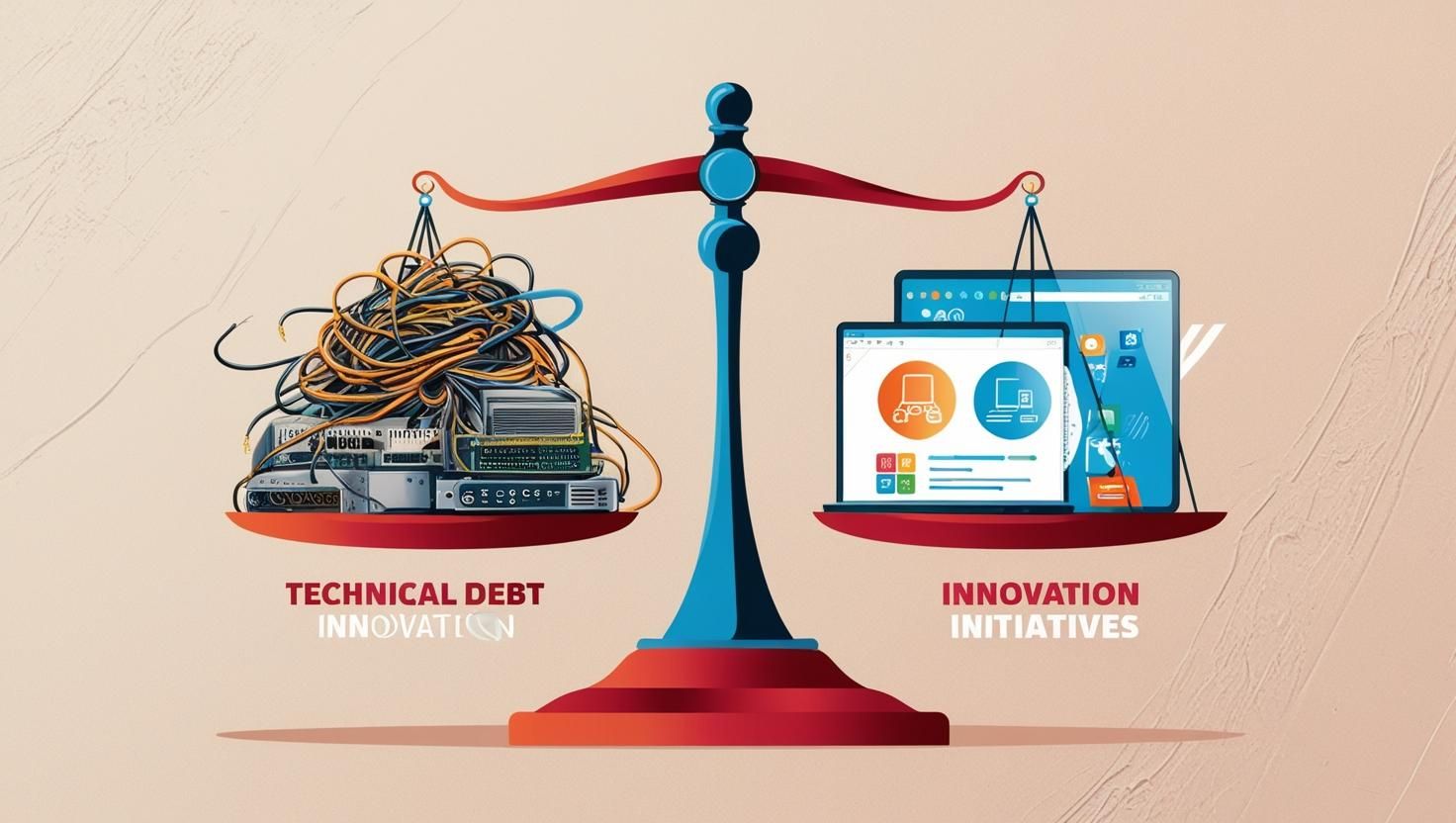- English
- Indonesia
Published by I Putu Arka Suryawan at Sat May 24 2025

A reflection from two decades of navigating the delicate dance between maintaining legacy systems and embracing cutting-edge technology
When I first started writing Clipper code for DOS applications back in the early 2000s, I never imagined I'd one day be architecting AI systems that transform entire business operations. Yet here I am, more than two decades later, having witnessed the evolution of technology from desktop applications to cloud-native AI solutions. This journey has taught me one crucial lesson: the key to a successful long-term tech career isn't just about learning new technologies—it's about mastering the art of balance between managing what exists and building what's next.
Technical debt isn't just a buzzword that project managers throw around during sprint planning. It's a very real challenge that every organization faces, especially those that have been in business for more than a few years. Think of it like a house that you've lived in for decades—over time, you've made quick fixes, added extensions, and patched things up. While the house still functions, it's not as efficient or elegant as it could be with a complete renovation.
In my experience working with businesses across various industries, I've seen how technical debt accumulates in predictable patterns. Legacy systems that were built quickly to meet immediate business needs often become the backbone of operations, even when they're no longer optimal. The challenge isn't just technical—it's deeply intertwined with business operations, user workflows, and organizational culture.
What makes this particularly interesting is how technical debt varies across different types of organizations. A startup might accumulate debt by choosing rapid development over perfect architecture, while an established enterprise might inherit decades-old systems that are mission-critical but difficult to modify. Both scenarios require different approaches, but the underlying principle remains the same: you need a strategy that acknowledges existing constraints while creating pathways for improvement.

Here's something I've learned from watching companies rise and fall over the past two decades: in technology, standing still is equivalent to moving backward. The businesses that thrive are those that continuously evolve their technical capabilities while maintaining operational stability. This isn't just about adopting the latest frameworks or jumping on every technology trend—it's about strategic innovation that aligns with business objectives.
When I transitioned my focus to AI technologies in 2023, it wasn't because AI was trendy. It was because I recognized that businesses needed new ways to handle increasing complexity, make sense of growing data volumes, and deliver personalized experiences at scale. The companies that embraced these capabilities early gained significant competitive advantages, while those that delayed found themselves playing catch-up.
Innovation in the context of technical debt management means being selective and strategic. Not every new technology deserves adoption, and not every legacy system needs immediate replacement. The art lies in identifying which innovations will deliver the most value and which existing systems can be enhanced rather than replaced entirely.
I've seen organizations transform their operations by implementing targeted AI solutions that work alongside existing systems, rather than requiring complete infrastructure overhauls. This approach allows for innovation without the massive disruption and cost associated with wholesale system replacement.

Over the years, I've developed a framework for approaching technical debt that balances pragmatism with progress. The first step is always assessment—understanding what you're working with before deciding what needs to change. This involves not just technical evaluation, but also understanding the business impact of existing systems and the risks associated with modification.
One approach that has served me well is the "strangler fig" pattern, where new functionality is built alongside existing systems, gradually taking over responsibilities until the old system can be safely retired. This method allows for continuous operation while enabling systematic modernization. I've successfully used this approach when helping businesses transition from legacy databases to modern cloud-based solutions.
Another critical strategy is incremental improvement. Rather than attempting massive overhauls, focus on making small, consistent improvements that compound over time. This might involve refactoring critical code paths, improving documentation, or adding automated testing to previously untested components. These improvements make future changes easier while reducing the risk of major failures.
Risk mitigation is paramount when working with legacy systems. Every change should be carefully planned, thoroughly tested, and have clear rollback procedures. I've learned this lesson through experience—both successful transitions and a few challenging situations that reinforced the importance of proper preparation and contingency planning.

Perhaps the most important lesson from my career journey is that technical excellence isn't just about individual skills—it's about fostering a culture where continuous improvement is valued and practiced consistently. This means creating environments where team members feel empowered to suggest improvements, where technical debt is regularly discussed and prioritized, and where learning new technologies is encouraged and supported.
In my current work with AI implementation, I've seen how teams that embrace continuous learning are better positioned to adapt to technological changes. They're more comfortable experimenting with new approaches, more effective at identifying opportunities for improvement, and more resilient when facing technical challenges.
Building this culture requires leadership that understands both the technical and business aspects of technology decisions. It means allocating time and resources for improvement activities, celebrating both successes and lessons learned from failures, and maintaining a long-term perspective even when facing short-term pressures.
The most successful organizations I've worked with treat technical debt management and innovation as complementary activities rather than competing priorities. They understand that well-maintained systems provide a stable foundation for innovation, while innovative solutions can help address technical debt more effectively than traditional approaches.
Looking ahead, I believe the key to long-term success in technology careers lies in developing this balanced perspective. Whether you're just starting your career or, like me, reflecting on decades of experience, the ability to manage existing systems while embracing new possibilities will remain crucial. Technology will continue evolving, but the fundamental challenge of balancing stability with progress will persist.
The future belongs to those who can bridge the gap between what is and what could be, creating pathways for improvement that honor existing investments while opening doors to new possibilities.